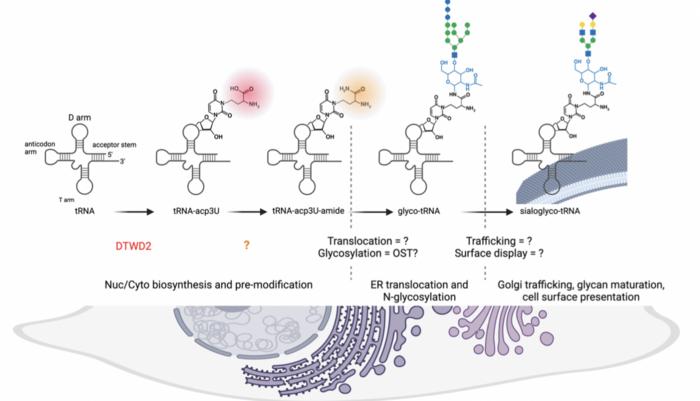In a groundbreaking exploration of cell surface biology, Ryan Flynn has uncovered a surprising role for RNA outside the confines of the cell. Flynn’s research, which focuses on the biology of cell surface RNA, led to the discovery that certain RNAs are chemically linked to glycans—complex carbohydrate polymers found on the cell surface.

Credit: Flynn Lab
In a groundbreaking exploration of cell surface biology, Ryan Flynn has uncovered a surprising role for RNA outside the confines of the cell. Flynn’s research, which focuses on the biology of cell surface RNA, led to the discovery that certain RNAs are chemically linked to glycans—complex carbohydrate polymers found on the cell surface.
In 2021, Flynn’s group was the first to report that RNA can be found outside of the cell. “What was particularly exciting about that discovery is that nucleic acids, like RNA, were traditionally thought to be confined within the cell and physically separate from glycobiology,” says Flynn, Assistant Professor of Stem Cell and Regenerative Biology and Principal Investigator at Boston Children’s Hospital. That discovery challenged the long-held notion that nucleic acids are restricted to the intracellular environment, revealing a previously unrecognized layer of complexity in cell surface biology.
In new research published today in Cell, Flynn and colleagues have discovered the mechanism of how RNA is chemically linked to N-glycans. Before this research, only proteins and lipids were known to be conjugated to glycans. Flynn’s team has now added RNA to this list, a finding with important implications for understanding cellular biology. “Our work proves that there are actually three classes of glycoconjugates: proteins, lipids, and RNAs,” he says. This discovery not only broadens the scope of known glycoconjugates but also opens new avenues for research into the functions of these glycoRNAs.
The Challenge of Proving the Existence of glycoRNAs
Despite the initial excitement surrounding Flynn’s 2021 discovery, there was a significant challenge: proving that these glycoRNAs truly existed as distinct molecules. Though the team presented data consistent with the existence of glycoRNAs, there was no direct evidence of a chemical linkage between the RNA and the glycan. This left room for reasonable skepticism within the scientific community, as some questioned whether the findings could be attributed to contaminants or other artifacts.
Addressing this outstanding question was top of mind – Flynn’s team has spent nearly four years working on this problem developing new techniques to establish definitive proof. “The work that we’ve done over the past four years in this context was focused on developing two things,” he explains. “On the technical side, we brought together a chemical approach to label the native glycoRNAs from any RNA source, and then we coupled it to a new, very sensitive style of mass spectrometry that enables RNA modification analysis.” These advancements allowed the team to identify multiple linkers–direct connections between an RNA base and a sugar–thus providing the first conclusive evidence of glycoRNAs as reported in the new Cell paper.
Implications for Cell Biology and Immunology
The implications of this research extend far beyond the simple identification of a new molecule. GlycoRNAs, as Flynn’s team discovered, could play a role in immune system interactions. “In the 2021 paper, we found evidence that glycoRNAs can interact with immune receptors,” he says. This suggests that glycoRNAs could be a crucial component in how the immune system recognizes and responds to cells, potentially influencing everything from pathogen detection to autoimmune responses.
The presence of glycoRNAs on the cell surface could also have broader implications for cell-cell communication and signaling. As Flynn elaborated, “If you’re trying to develop a mechanism understanding of why someone has autoimmunity, if you don’t think about the RNA on the cell surface, you’ll necessarily be missing something.”
Flynn’s research has reshaped the field of glycobiology. Prior to this work, the idea of glycoRNAs was met with skepticism. Now, as Flynn highlighted, the most recent edition of the Essentials of Glycobiology reference book refers to glycoRNAs as one of the “big” questions in glycobiology.
This shift in focus reflects the growing recognition of glycoRNAs as an important study area. “The goal of this is to stimulate more interest in glycoRNA biology and cell surface RNA biology,” Flynn emphasizes. “This paper not only expands the understanding of RNA biology but has also opened up new possibilities for research into cell surface interactions and immune system function.”
As the scientific community begins to explore this uncharted territory, the impact of Flynn’s research will likely drive new discoveries and potentially lead to novel therapeutic strategies. Says Flynn, “We think this is going to change the view of its glycoRNA validity because it will be the direct evidence that a lot of the chemists and the glycobiologists were waiting for.”
Journal
Cell
Method of Research
Experimental study
Subject of Research
Cells
Article Title
The modified RNA base acp3U is an attachment site for N-glycans in glycoRNA
Article Publication Date
21-Aug-2024



